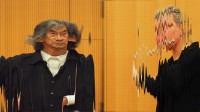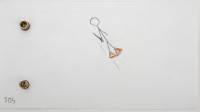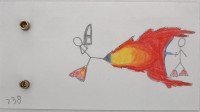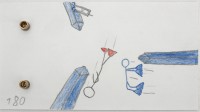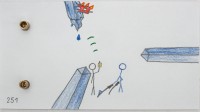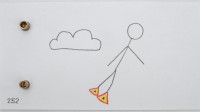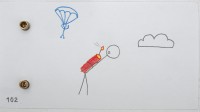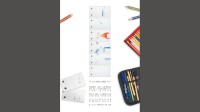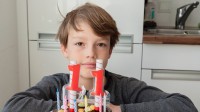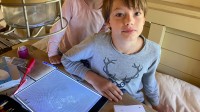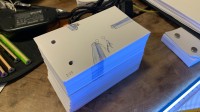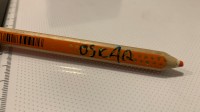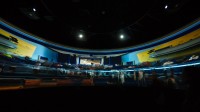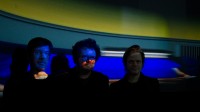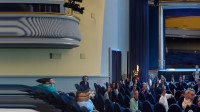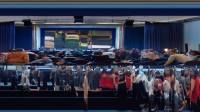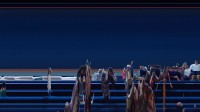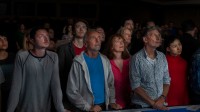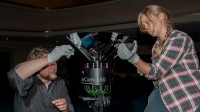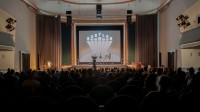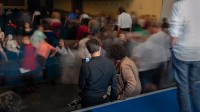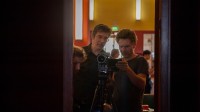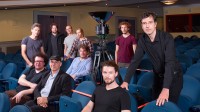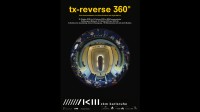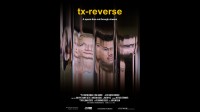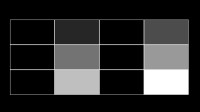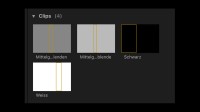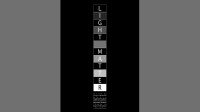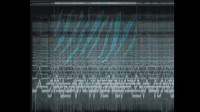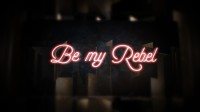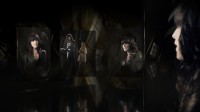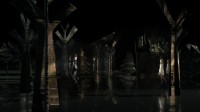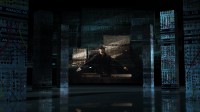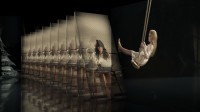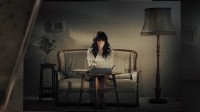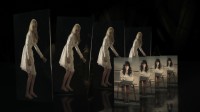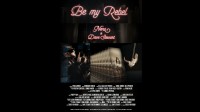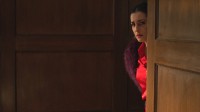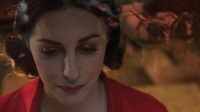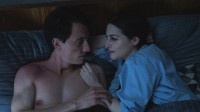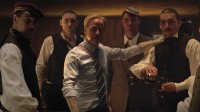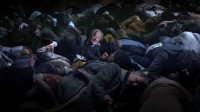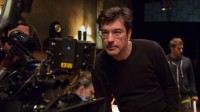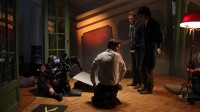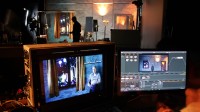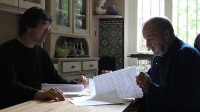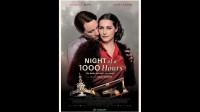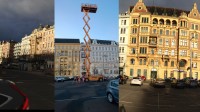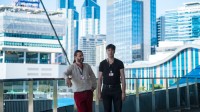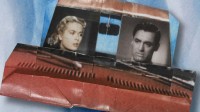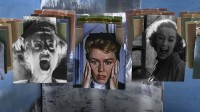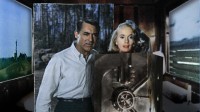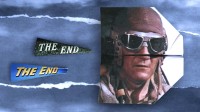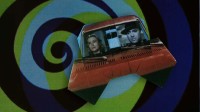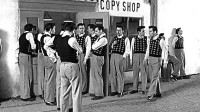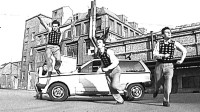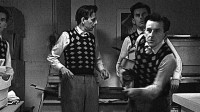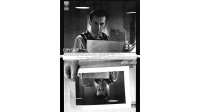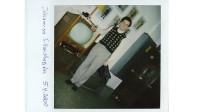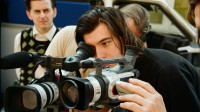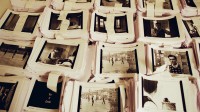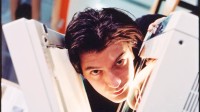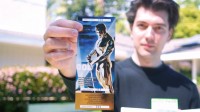Complete filmography of Virgil Widrich
Overview of Virgil Widrich's films in various formats (short, animated and feature films, experimental and avant-garde films): from future works still in production to the first Super 8 films made at Mönchsberg in Salzburg at the age of 13.Microconcert Philharmonic State Orchestra Hamburg
With the microconcerts, Kent Nagano,
Georges Delnon and the Philharmonic State Orchestra Hamburg provide a response to the pandemic and its consequences of media
overload. In collaboration with international video artists, a cycle of five audiovisual concert programs has been created
in which classical music meets contemporary video art. Following an exclusive streaming on Radio France, the videos are also
online on the channels of the Philharmonic State Orchestra and the Hamburg State Opera.
Virgil Widrich visualized five pieces of music using the film technique tx-transform, which exchanges the time and space axes.
Link to YouTube.
Virgil Widrich visualized five pieces of music using the film technique tx-transform, which exchanges the time and space axes.
Link to YouTube.
There is exactly enough time
A 2021, short film, DCP, 4K/2K, color, 1:1.85, stereo
length: 2 min.
Link to the trailer and to the whole film.
Oskar Salomonowitz, the 12-year-old son of filmmakers Anja Salomonowitz and Virgil Widrich, had drawn 206 frames of a flip book when he died in an accident. Using the remaining blank sheets, his father continued drawing the film.
"Oskar never showed me his drawings in detail because he did not want to showcase an unfinished film. At first, I had no idea whatsoever how the story should continue, and the beginning was very difficult for me. I practiced Oskar's stroke for a long time for fear of doing something wrong, but that's what definitely would have made my style be different from his, because he wasn't afraid at all. Oskar conceived his project as a flip book and not necessarily as a film, but his stack would have been far too thick to flip through evenly. In the end, I would have suggested to him that we photograph his drawings and then turn them into an animated film with sound. I am sure he would have liked this format very much and it being screened in the cinema." (Virgil Widrich)
Winner of 86 international film awards!
length: 2 min.
Link to the trailer and to the whole film.
Oskar Salomonowitz, the 12-year-old son of filmmakers Anja Salomonowitz and Virgil Widrich, had drawn 206 frames of a flip book when he died in an accident. Using the remaining blank sheets, his father continued drawing the film.
"Oskar never showed me his drawings in detail because he did not want to showcase an unfinished film. At first, I had no idea whatsoever how the story should continue, and the beginning was very difficult for me. I practiced Oskar's stroke for a long time for fear of doing something wrong, but that's what definitely would have made my style be different from his, because he wasn't afraid at all. Oskar conceived his project as a flip book and not necessarily as a film, but his stack would have been far too thick to flip through evenly. In the end, I would have suggested to him that we photograph his drawings and then turn them into an animated film with sound. I am sure he would have liked this format very much and it being screened in the cinema." (Virgil Widrich)
Winner of 86 international film awards!
tx-reverse
A space time cut through cinema.
Austria/Germany 2018, short film, DCP, color, 1:2,39 / "tx-reverse 360°": Austria/Germany 2019, installation in 360°, 10K
Length: 5 min.
Link to the trailer.
What is behind the cinema screen? It is not surprising that cinema-in-the-cinema scenes are often used in horror films. For they irritate and unsettle by reminding us – the immobile viewers hidden in the cosy darkness – of our own questionable position. What if the forces of unlimited imagination penetrate through the canvas into our reality? What if the auditorium dissolves and with it the familiar laws of cinema itself? In a way never before seen, "tx-reverse" shows this collision of reality and cinema and draws its viewers into a vortex in which the familiar order of space and time seems to be suspended.
Back in the 1990s, Martin Reinhart invented a film technique called "tx-transform", which exchanges the time (t) and space axis (x) in a film. Normally, each individual film frame represents the entire space, but only a brief moment of time (1/24 second). In the case of tx-transformed films, however, the opposite is true: each film frame shows the entire time, but only a tiny part of the space – in cuts along the horizontal spatial axis, the left part of the image thus becomes the "before", the right part the "after".
20 years after Martin Reinhart and Virgil Widrich used this film technique for the first time in a short film ("tx-transform", 1998), they again deal with the question of which previously unseen world arises when space and time are interchanged, aptly in a cinema and at full 360°: at the Babylon Kino in Berlin they filmed with the OmniCam-360 about 135 actors and calculated the installation "tx-reverse 360°" for the ZKM from this material.
Winner of 39 international film awards!
Austria/Germany 2018, short film, DCP, color, 1:2,39 / "tx-reverse 360°": Austria/Germany 2019, installation in 360°, 10K
Length: 5 min.
Link to the trailer.
What is behind the cinema screen? It is not surprising that cinema-in-the-cinema scenes are often used in horror films. For they irritate and unsettle by reminding us – the immobile viewers hidden in the cosy darkness – of our own questionable position. What if the forces of unlimited imagination penetrate through the canvas into our reality? What if the auditorium dissolves and with it the familiar laws of cinema itself? In a way never before seen, "tx-reverse" shows this collision of reality and cinema and draws its viewers into a vortex in which the familiar order of space and time seems to be suspended.
Back in the 1990s, Martin Reinhart invented a film technique called "tx-transform", which exchanges the time (t) and space axis (x) in a film. Normally, each individual film frame represents the entire space, but only a brief moment of time (1/24 second). In the case of tx-transformed films, however, the opposite is true: each film frame shows the entire time, but only a tiny part of the space – in cuts along the horizontal spatial axis, the left part of the image thus becomes the "before", the right part the "after".
20 years after Martin Reinhart and Virgil Widrich used this film technique for the first time in a short film ("tx-transform", 1998), they again deal with the question of which previously unseen world arises when space and time are interchanged, aptly in a cinema and at full 360°: at the Babylon Kino in Berlin they filmed with the OmniCam-360 about 135 actors and calculated the installation "tx-reverse 360°" for the ZKM from this material.
Winner of 39 international film awards!
Light Matter
A 2018, Short, DCP, 2K, 1:1,85, Stereo
Length: 5 min.
A black-and-white film that lets you see colors.
Initially barely noticeable, the initially dim flashes of light become continuously brighter and more intense over a period of five minutes. Towards the end they become a staccato of light and dark stimuli that evoke psychedelic colour impressions in the audience. If you pause the film, however, it becomes apparent that it consists merely of a rhythmic sequence of white, grey and black frames and does not contain any colour information itself. But what causes these surprisingly strong illusions?
"Light Matter" takes advantage of a physiological phenomenon that was described by Gustav Theodor Fechner and Hermann von Helmholtz as early as the middle of the 19th century but has not yet been satisfactorily explained by science. Around the turn of the century, the effect was finally commercialized as an optical toy and has since been named after its inventor, the English toymaker Charles Benham. The point is that the rapid change from light to dark triggers color perception in the brain without the detour via the receptors of color vision in the eye. However, the colour perceptions produced in this way are extremely subjective and depend on many factors - e.g. smokers see no or other colours as non-smokers.
Virgil Widrich's film, however, does not stop at exploring and re-enacting a physiological experimental arrangement, but rather questions in an unexpected and clear way what cinema is. In "Light Matter" its conception is shaken by the fact that the material basis of the visual illusion is missing, but that it arises completely in the minds of the audience. Since everyone perceives the film differently, the self-evident nature of collective viewing may not arise either. Siegfried Friedrich's psychoacoustic music, which combines accelerating pulsations with spectral textures, further strengthens the highly individual perception.
Martin Reinhart
Attention! This film contains flashing lights which may not be suitable for light-sensitive epilepsy.
Winner of 13 international film awards!
Link to the trailer.
Length: 5 min.
A black-and-white film that lets you see colors.
Initially barely noticeable, the initially dim flashes of light become continuously brighter and more intense over a period of five minutes. Towards the end they become a staccato of light and dark stimuli that evoke psychedelic colour impressions in the audience. If you pause the film, however, it becomes apparent that it consists merely of a rhythmic sequence of white, grey and black frames and does not contain any colour information itself. But what causes these surprisingly strong illusions?
"Light Matter" takes advantage of a physiological phenomenon that was described by Gustav Theodor Fechner and Hermann von Helmholtz as early as the middle of the 19th century but has not yet been satisfactorily explained by science. Around the turn of the century, the effect was finally commercialized as an optical toy and has since been named after its inventor, the English toymaker Charles Benham. The point is that the rapid change from light to dark triggers color perception in the brain without the detour via the receptors of color vision in the eye. However, the colour perceptions produced in this way are extremely subjective and depend on many factors - e.g. smokers see no or other colours as non-smokers.
Virgil Widrich's film, however, does not stop at exploring and re-enacting a physiological experimental arrangement, but rather questions in an unexpected and clear way what cinema is. In "Light Matter" its conception is shaken by the fact that the material basis of the visual illusion is missing, but that it arises completely in the minds of the audience. Since everyone perceives the film differently, the self-evident nature of collective viewing may not arise either. Siegfried Friedrich's psychoacoustic music, which combines accelerating pulsations with spectral textures, further strengthens the highly individual perception.
Martin Reinhart
Attention! This film contains flashing lights which may not be suitable for light-sensitive epilepsy.
Winner of 13 international film awards!
Link to the trailer.
Micromeo
(in development for 2022+)
A/Lux, 2020, Animation
length: 90 min.
Romeo and Juliet in the microcosm of the human body... Forbidden love between the young Bacterium Micromeo and Antibody-girl Globia threatens the harmony of the immune system, leading to war between ambitious leaders, and finally awakening a genetic monster that is ready to exterminate them all. "Love is stronger than dirt!"
A/Lux, 2020, Animation
length: 90 min.
Romeo and Juliet in the microcosm of the human body... Forbidden love between the young Bacterium Micromeo and Antibody-girl Globia threatens the harmony of the immune system, leading to war between ambitious leaders, and finally awakening a genetic monster that is ready to exterminate them all. "Love is stronger than dirt!"
Nena & Dave Stewart: Be my Rebel
D 2018, music video, DCP, 1:1.78
Length: 3 min. 45 sec.
Children dream of what they will be as adults and adults dream about their childhood. But sometimes, when orderly life becomes paralyzed in routine, adults need the inner child to bring about change: "Be my rebel", the first collaboration of the two music legends Nena and Dave Stewart, premiered at Nena's 40th anniversary on stage. The accompanying video by Oscar-nominated filmmaker Virgil Widrich transfers the story into a dreamlike, glass mirror world that is powered by Dave Stewart at the controls of his classic modular synthesizers. At the typewriter: Nena as an annoyed bookkeeper, who threatens to disappear soon with her flower dress in her flower wallpaper. But the inner dialogue works in both directions and soon takes effect: rebellion changes the past – and thus also the future.
Winner of 47 international film awards!
Link to video and interview...
Length: 3 min. 45 sec.
Children dream of what they will be as adults and adults dream about their childhood. But sometimes, when orderly life becomes paralyzed in routine, adults need the inner child to bring about change: "Be my rebel", the first collaboration of the two music legends Nena and Dave Stewart, premiered at Nena's 40th anniversary on stage. The accompanying video by Oscar-nominated filmmaker Virgil Widrich transfers the story into a dreamlike, glass mirror world that is powered by Dave Stewart at the controls of his classic modular synthesizers. At the typewriter: Nena as an annoyed bookkeeper, who threatens to disappear soon with her flower dress in her flower wallpaper. But the inner dialogue works in both directions and soon takes effect: rebellion changes the past – and thus also the future.
Winner of 47 international film awards!
Link to video and interview...
Icon Island – a live battle of pictures and sounds
A 2018, live performance, full
HD, 16:9
Length: approx. 70 min.
Carefully selected visuals, many including a connection to Malta and its cinematic history, will be projected as a ‘live’ mix accompanied by a live electronic music performance by Maltese artist Sonitus Eco, the latter performed instinctively and spontaneously as an improvised soundtrack to the ephemeral visuals. The sounds of the films are re-imagined on the fly, the pictures react to – or even oppose – the sound. Man against island, picture against sound.
The collage of visuals is inspired by films dealing with the mystic and romantic journey to islands representing alternative societies or different states of mind: sometimes those places, questioning the custom identity of their visitors, are paradise and a threat at the same time.
Length: approx. 70 min.
Carefully selected visuals, many including a connection to Malta and its cinematic history, will be projected as a ‘live’ mix accompanied by a live electronic music performance by Maltese artist Sonitus Eco, the latter performed instinctively and spontaneously as an improvised soundtrack to the ephemeral visuals. The sounds of the films are re-imagined on the fly, the pictures react to – or even oppose – the sound. Man against island, picture against sound.
The collage of visuals is inspired by films dealing with the mystic and romantic journey to islands representing alternative societies or different states of mind: sometimes those places, questioning the custom identity of their visitors, are paradise and a threat at the same time.
Night of a 1000 Hours
Lux/A/NL 2016, feature film, DCP, 1:2,39, Dolby Digital
Length: 92 min.
When the ambitious Philip takes over the running of the family business from his father, he finds himself confronted by the mysterious reappearance of his dead ancestors. In the course of a long night, during which there are a murder, an illicit love affair and a game with false identities, Philip uncovers a closely guarded family secret.
Winner of "Flash Forward Audience Award" at Busan International Film Festival 2016!
Link to Trailer and "Making-of"
Length: 92 min.
When the ambitious Philip takes over the running of the family business from his father, he finds himself confronted by the mysterious reappearance of his dead ancestors. In the course of a long night, during which there are a murder, an illicit love affair and a game with false identities, Philip uncovers a closely guarded family secret.
Winner of "Flash Forward Audience Award" at Busan International Film Festival 2016!
Link to Trailer and "Making-of"
Vienna table trip
A 2016, short film, advertisement, DCP, 1:1,78, Dolby SR
Length: 1 min. 22 sec.
"The coffee table is a microcosm of Vienna because basically, you do not need to leave the coffee house to travel once through the whole of Vienna. This idea eventually led to the idea of a miniature journey through the city, staged with saucers, cups, plates, knives, forks and souvenirs – garnished with projected memories and the many starters, main courses and desserts one can so often find here." (Virgil Widrich)
Winner of 25 international awards or honorable mentions!
Link to Film and Making of...
Length: 1 min. 22 sec.
"The coffee table is a microcosm of Vienna because basically, you do not need to leave the coffee house to travel once through the whole of Vienna. This idea eventually led to the idea of a miniature journey through the city, staged with saucers, cups, plates, knives, forks and souvenirs – garnished with projected memories and the many starters, main courses and desserts one can so often find here." (Virgil Widrich)
Winner of 25 international awards or honorable mentions!
Link to Film and Making of...
back track
A 2015, short film, Stereo DCP, black/white, 1:2,39
Length: 7 min.
Virgil Widrich's short film is a 7-minute 3D-remix of feature films from the 1950s and 60s which were projected on glass and photographed in 3D. The World premiere at the 61st International Short Film Festival Oberhausen. Additional festivals: Diagonale, Zagreb Animafest, Karlovy Vary, Vila do Conde, Wroclaw, Bristol, Sevilla, Cambridge, Milano, and Wiesbaden. Winner of 15 international film awards!
Link to making of; download press kit
"'back track' presents itself as yet another work of bravura by one of Austria’s most inventive filmmakers, his ingeniously intricate ideas ever a source of newfound pleasure."
Peter Tscherkassky
Length: 7 min.
Virgil Widrich's short film is a 7-minute 3D-remix of feature films from the 1950s and 60s which were projected on glass and photographed in 3D. The World premiere at the 61st International Short Film Festival Oberhausen. Additional festivals: Diagonale, Zagreb Animafest, Karlovy Vary, Vila do Conde, Wroclaw, Bristol, Sevilla, Cambridge, Milano, and Wiesbaden. Winner of 15 international film awards!
Link to making of; download press kit
"'back track' presents itself as yet another work of bravura by one of Austria’s most inventive filmmakers, his ingeniously intricate ideas ever a source of newfound pleasure."
Peter Tscherkassky
warning triangle
A 2011, short film, Video, 4:3
Length: 6 min.
A found footage film collage about the destructive triangle between a man, a woman, and her car. Produced for the exhibition "Car Fetish. I drive, therefore I am." for the Museum Tinguely, Basel.
YouTube: film
Length: 6 min.
A found footage film collage about the destructive triangle between a man, a woman, and her car. Produced for the exhibition "Car Fetish. I drive, therefore I am." for the Museum Tinguely, Basel.
YouTube: film
make/real
A 2010, short film, video, 4:3
Length: 5 min.
A surreal montage of science fiction films about the public image oft the robot, collected for the exhibition "Robot Dreams" at the Kunsthaus Graz and the Museum Tinguely, Basel.
YouTube: film
Length: 5 min.
A surreal montage of science fiction films about the public image oft the robot, collected for the exhibition "Robot Dreams" at the Kunsthaus Graz and the Museum Tinguely, Basel.
YouTube: film
Fast Film
A/Lux 2003, short film, 35 mm, 1:1,66, Dolby SRD
Length: 14 min.
"Fast Film" is an animated homage to motion pictures, hand-made by folding 65,000 print outs of film frames into three-dimensional objects. The film won 35 international awards.
Download photos
YouTube: making of Fast Film
Link to film's website
Length: 14 min.
"Fast Film" is an animated homage to motion pictures, hand-made by folding 65,000 print outs of film frames into three-dimensional objects. The film won 35 international awards.
Download photos
YouTube: making of Fast Film
Link to film's website
Leftright
A/F 2001, short film, DV-CAM
Length: 4:09 min
Interviews with Bady Minck, Ruth Beckermann, Hans Hurch, Peter Tscherkassky, Florian Flicker, Alexander Ivanceanu, Michael Kreihsl and Wolfgang Lehner about "left" and "right" in film and politics.
Length: 4:09 min
Interviews with Bady Minck, Ruth Beckermann, Hans Hurch, Peter Tscherkassky, Florian Flicker, Alexander Ivanceanu, Michael Kreihsl and Wolfgang Lehner about "left" and "right" in film and politics.
Copy Shop
A 2001, short film, 35 mm, 1:1,66, Dolby SR
Length: 12 min.
The story of a man who copies himself until he fills up the entire world. The film won 43 international awards and was nominated for the Oscar 2001 (best short film).
Youtube: film and making of
Link to film's website
"A dazzling nightmare" - The Guardian, London
Length: 12 min.
The story of a man who copies himself until he fills up the entire world. The film won 43 international awards and was nominated for the Oscar 2001 (best short film).
Youtube: film and making of
Link to film's website
"A dazzling nightmare" - The Guardian, London
Brighter than the Moon
Europe 2000, feature film, 35 mm, 1:1,85, Dolby Surround
Length: 88 min.
A moonstruck comedy about robbers and lovers. City of Salzburg's Screenplay Award 1997, award for Lars Rudolph (Festival Angers France), LVT-Subtitling Award (Festival Angers France).
YouTube: trailer
Link to film's website
Length: 88 min.
A moonstruck comedy about robbers and lovers. City of Salzburg's Screenplay Award 1997, award for Lars Rudolph (Festival Angers France), LVT-Subtitling Award (Festival Angers France).
YouTube: trailer
Link to film's website
tx-transform
A 1998, short film, 35 mm, Cinemascope, 1:2,39, Dolby
SR
Length: 5 min.
tx-transform is a film technique that transposes the time axis (t) and one of the space axes (x or y) with one another. Normally, each individual frame of a film depicts the entire space, but only a moment in time (1/24 second). With tx-transformed films, it is just the opposite: each frame shows the entire time, but only a tiny portion of space – if one cuts alongside the horizontal space axis, the left portion of the picture turns into the "the before", the right one into "the after". This produces phenomena such as those described by Einstein in his theory of relativity.
Link to filmwebsite
YouTube: film
Length: 5 min.
tx-transform is a film technique that transposes the time axis (t) and one of the space axes (x or y) with one another. Normally, each individual frame of a film depicts the entire space, but only a moment in time (1/24 second). With tx-transformed films, it is just the opposite: each frame shows the entire time, but only a tiny portion of space – if one cuts alongside the horizontal space axis, the left portion of the picture turns into the "the before", the right one into "the after". This produces phenomena such as those described by Einstein in his theory of relativity.
Link to filmwebsite
YouTube: film
The Spirit of Time
A 1983-1985, Super-8-mm
Length: 112 min.
A genre cross-over mixing action, horror and science fiction in the past, present and future. Virgil Widrich completed this full-length film at the age of 17.
"Two hours of cinematic fireworks." (Horst Christoph, Profil)
Length: 112 min.
A genre cross-over mixing action, horror and science fiction in the past, present and future. Virgil Widrich completed this full-length film at the age of 17.
"Two hours of cinematic fireworks." (Horst Christoph, Profil)
Monster in Salzburg
A 1982, Super-8-mm
Length: 12 min., 48 meters
A gigantic insect-like monster destroys the city of Salzburg. An oedipal drama.
Length: 12 min., 48 meters
A gigantic insect-like monster destroys the city of Salzburg. An oedipal drama.
Color can dream
A 1981, Super-8-mm
Length: 9 min., 42 meters
Animated film by the then 13-year-old Virgil Widrich about a man and a small worm fleeing environmental destruction.
Length: 9 min., 42 meters
Animated film by the then 13-year-old Virgil Widrich about a man and a small worm fleeing environmental destruction.
3 times Ulf
A 1980, Super-8-mm
Length: 12 min., 48 meters
On behalf of Arnulf Komposch.
Documentary about the Carinthian "mirror artist" Arnulf Komposch.
Length: 12 min., 48 meters
On behalf of Arnulf Komposch.
Documentary about the Carinthian "mirror artist" Arnulf Komposch.
Fried Meat
A 1980, Super-8-mm
Length: 11 min., 44 meters
Crime story: A woman is killed in a Restaurant and served to the guests.
Length: 11 min., 44 meters
Crime story: A woman is killed in a Restaurant and served to the guests.
Gusti Kupelwieser
A 1980, Super-8-mm
Length: 6 min., 25 meters
Documentary about Gusti (Auguste) Kupelwieser (1907-1987), the grandmother of the director.
Length: 6 min., 25 meters
Documentary about Gusti (Auguste) Kupelwieser (1907-1987), the grandmother of the director.
My Homelife
A 1980, Super-8-mm
Length: 6 min., 27 meters
Documentary about the old house of the Widrich family.
Length: 6 min., 27 meters
Documentary about the old house of the Widrich family.

